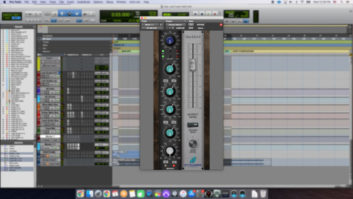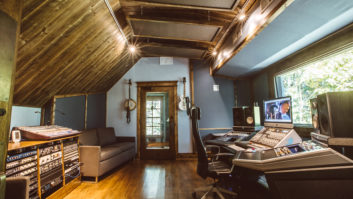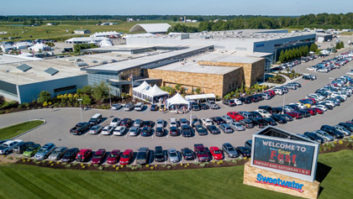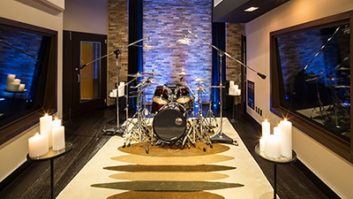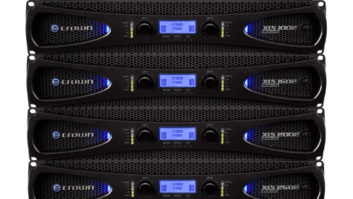On the Cover: PatchWerk Recordings
Completed in July 2001, PatchWerk Recordings’ (Atlanta) new “Studio 9000” was designed by Russ Berger Design Group. PatchWerk was founded in the mid-’90s by Bob Whitfield, a pro football player for the Atlanta Falcons who is also a musician. The facility was built into an existing warehouse that required extensive reconstruction to become both aesthetically and sonically suitable as a studio. Of primary importance to the design process were the size and sonics of the control room, and sightlines from that room into all of the recording spaces. “The area we had to work with is very tight,” explains Berger. “The SSL that’s in there is over 18 feet wide. We had to allow room, obviously, to get around it, and to provide an area of good listening all the way to the end of this console.”
A corner window provides views from the control room into three iso booths as well as the main recording room. Berger says that in the big room, the client needed “an open, airy sound for certain instruments, like percussion, but because they also do a lot of rap and hip hop, they need certain instruments, when they’re pushed way forward in the mix, to be very dry so they have absolute control. So, we have a booth that offers that, and there is an alcove area in the studio that allows them to get that really dead, dry sound, but both of those spaces can be used to speak into the main space.” Featured equipment includes the large SSL 9096J console, Quested 412HM main monitors, a Lexicon 960L digital effects system and three Alesis ADAT XTs with BRC. Recording is to Studer A827 24-track, 2-inch recorders and Pro Tools 5.1.1.
Sony Music Studios Tokyo
Sony Music Studios Tokyo is one of the largest ground-up, high-end studio facilities of recent years, with five recording studios, 12 mastering suites and nine authoring studios housed in a single building. Designed by studio bau:ton with Tokyo-based architect/contractor Obayashi Corporation, it opened in May 2001. Equipment of note includes TEC:ton TTH-1 soffited far-field main monitors, with Tannoy SGM-10 and Yamaha NS10M nearfields. Recording is to Sony, Euphonix and Studer machines. Studios 1, 2 and 3 feature Neve 8872 consoles; Studio 4 houses a SSL 9072 J; and a Euphonix System 5 is at work in Studio 5.
Global Fusion
Opened in April 2002, Global Fusion’s (Monterrey, Mexico) new room, El Cielo, was designed by George Newburn of Studio 440. The room is equipped with a 72-channel SSL 9000 J Series SuperAnalogue Console with SL 959 surround monitor section, Genelec 1035 (LCR) and 1038 (L/R rear) monitors and a Genelec 1094 sub. The room also features two Studer A827s, Pro Tools Mix|24 CUBE and HD192, and Otari RADAR II. Its main room is large enough to fit a 50-piece orchestra; other features include three iso booths, two lounges, a full kitchen and countless amenities.
Crunch Recording Group
This new room for the Crunch Recording Group (Toronto) was a redesign of an existing space by Pilchner Schoustal International Inc., incorporating new ceiling systems and treatment, and mechanical systems and video projection addition. Room treatments feature RPG Diffusors mounted in an array located in the rear wall’s LF trapping. A window provides natural light into the space. The room reopened in March 2002, with marquee gear that includes Digidesign Control|24, M&K 2510P 5.1 surround monitor system and Soundminer Network with 200,000 effects.
Soundmirror
Soundmirror is a mastering and post-production facility that specializes in location recording of acoustic and classical music, as well as post-production for music mixing/editing and CD mastering, and SACD recording and editing. Based in Boston, the facility brought in Tom Horrall of Acentech to build its new Studio D, which opened in September 2001. Featured gear includes a Sony DMX-R100 console, Pyramix PCM and SACD workstation, and B&W loudspeakers.
Mi Casa Multimedia Inc.
Los Angeles-based Mi Casa Multimedia Inc., a two-room, home theater-style facility, was designed in association with the Walters-Storyk Design Group, with additional acoustical consultation by Waterland Design’s Vincent Van Haaff. Located in a 1928 Spanish Revival house formerly owned by actor Bela Lugosi, each room is identically equipped with a Sony DMX-R100 digital mixing console, a TC Electronic System 6000 multichannel processor, Z-Systems Detangler Pro 64×64 digital audio routers and a SADiE Artemis 24-track workstation. Open in late October 2001, the facility is seeing a large amount of high-profile 5.1 DVD mixing and mastering work. Shown: The Livingroom.
Salmon Peak Studios
The warm, creative vibe at Salmon Peak Studios (San Antonio, Texas) is in large part due to the design by Jack Piercy of Acoustech Studio Services, with system design by RB Blackstone of Sound Madness. Features include a control room with a vintage Neve 8232 console, coupled with a spacious tracking room and five iso booths (pictured). Monitoring is through soffit-mounted, JBL-modified UREI mains, and Genelec and Yamaha near-fields. Recording is to MCI/Sony JH24 2-inch 24-track analog, as well as 24 tracks of Pro Tools|24 MIXplus. The facility opened in December 2001.
Firehouse Recording Studios
Constructed in the livery of the 1889 Firehouse (Pasadena, Calif.), this facility was founded by producer/songwriter Tena Clark. Designed by Studio 440 with integration by Paul Cox, the 5.1 studios not only house the 48-track Pro Tools HD192 system, but also offer classic analog equipment, vintage mics and a Bösendorfer grand piano (pictured). Composer Mark Mancina has set up a satellite studio within the facility.
Sonica Recording
Built into a 1920s-era building, Sonica Recording (Atlanta), completed in the fall of 2001, was designed and built by John and Steve Briglevich. The single-room facility features a custom API 3232 console, Studer recorders, Pro Tools MIXplus, and an extensive list of mics, outboard gear and musical instruments. The studio also boasts Equi=tech balanced power throughout. More than 100 tons of sand was used in the massive masonry wall structures of the facility.
Avenue Edit
New York City-based Janson Design Group’s work for Chicago’s Avenue Edit’s new 7,500-square-foot audio post-production facility included three identical 750-square-foot audio post rooms, two with large iso booths and the third with a Foley stage. Each room is equipped for 5.1, and has a custom production station featuring a Euphonix System 5 digital console and an integrated Fairlight MFX3 Plus workstation. Speakers are Genelec 1037B (L/C/R), 1019As for rears and a 1094B sub. Video projectors are Sony VPL-VW10HT. The facility opened in July 2001.
Crossroads Productions
Crossroads Productions (Vancouver, Wash.), designed by Russ Berger Design Group and opened in February 2002, boasts a Neve 5315 console with a Geoff Tanner 24×2 custom monitor section. Utilizing the exterior slot windows, a low-frequency quadratic residue diffuser forms one of the wells in the mathematical diffuser series. The room is capable of recording to Otari MX-80 2-inch, 24-track and 3M M79 half-inch, 2-track, as well as Pro Tools MIXplus. The Crossroads studio also doubles as a choir rehearsal room for Crossroads Community Church.
Stratosphere Studios
New York City-based Stratosphere Studios was conceived as a private-use facility for the three partners (Andy Chase of IVY, Adam Schlesinger from Fountains of Wayne, and James Iha of Smashing Pumpkins fame), as well as a commerical studio open for bookings with developing artists from major labels. Completed in July 2001, Studio A was designed for a relaxed feel by Francis Manzella Design and features a Neve 8068 console modified by Dan Zelman, Genelec 1039 active mains and Pro Tools Mix|24. The room also is home to a diverse group of outboard gear, mics and studio instruments.
Eloy Productions
Eloy Productions (Tustin, Calif., owned by John Zsatai) was designed by Chris Pelonis of Pelonis Sound and Acoustics and built by Rick Ruzzamenti, Stewart Whitehair and Bob Wilder. The 5.1 control room houses an Oram BEQ 24/40 console and Pelonis Signature Series monitors. Recording is to Pro Tools or 2-inch, and outboard gear is from TC Electronic, Lexicon, Avalon and Tube-Tech. Eloy Productions’ control room and tracking room (pictured) opened in February 2002. The facility also boasts a stereo control room and six recording spaces.
Studio on the Hill
Crossroads Tabernacle and The Boden Center for the Performing Arts, previously an old marquis movie theater, is now a church in The Bronx. John Storyk and Beth Walters of the Walters-Storyk Design Group co-designed the state-of-the-art A/V production studio and are refurbishing an 800-plus-seat theater for worship, concerts, dramas and outreach events. The 1,000-plus-square-foot studio, which went online in September 2001, is equipped with a Sony DMX-R100 digital console and Genelec 1038 monitors.
Harbor House Studios
Located at Anchor Church in Keller, Texas, Harbor House Studios opened in September 2001 as a full-service audio/visual facility, with architecture and acoustical design by Russ Berger Design Group. Featuring 24 channels of Apogee’s AD-8000, Digidesign Pro Tools 24 Mix3 System, and Genelec 1031 monitors and 1092A subwoofers, Harbor House Studios can record from the adjacent 500-seat auditorium, as well as the studio and iso booths. There’s a healthy array of outboard gear from Avalon, Focusrite, API and Furman. Clerestory windows allow natural light into the studio.
Adventist Media Productions
Adventist Media Production’s Audio Studio A (mixing and overdub room) was designed by Carl Yanchar of Wave:Space, with system design and install by Chris James, senior recording engineer at AM Productions. Studio A features Pro Tools 5.1.3 with Pro Control, Edit Pack and MixPlus system with five DSP cards, a Martech MultiMAX unit and 42-inch plasma display for video playback. Mains are Tannoy DMTII 215s, and rears are Tannoy System 800As. The room also features an extensive complement of outboard gear and mics. Opened in February 2002, AMP is just minutes from downtown Hollywood.
